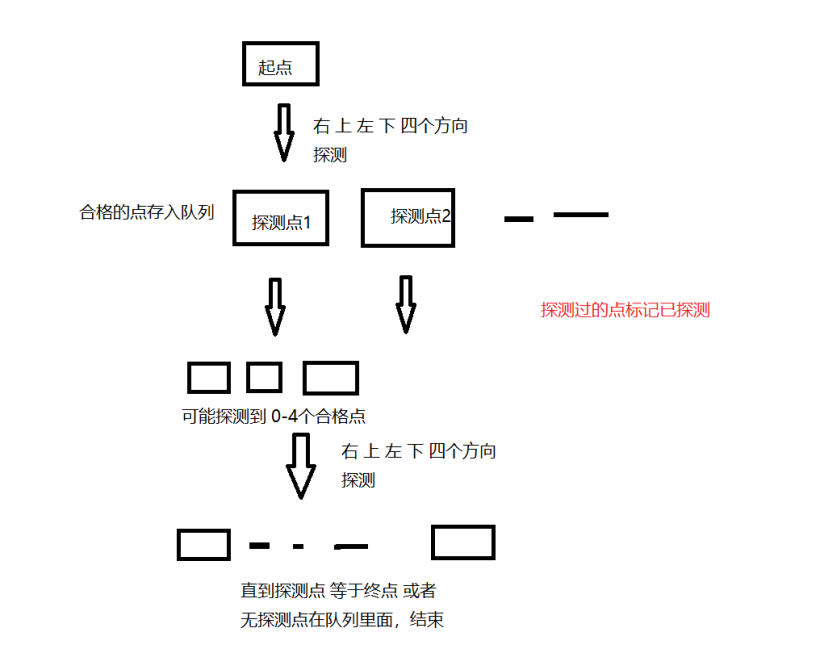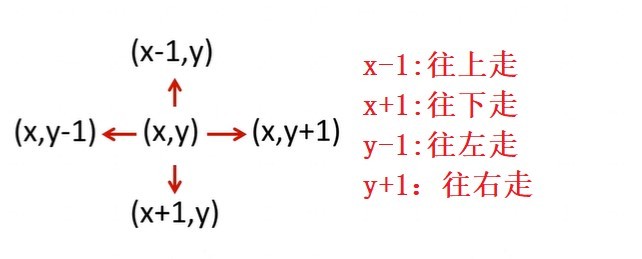

openharmony 军棋工兵寻径算法的实现
source link: https://ost.51cto.com/posts/19927
Go to the source link to view the article. You can view the picture content, updated content and better typesetting reading experience. If the link is broken, please click the button below to view the snapshot at that time.

openharmony 军棋工兵寻径算法的实现
工兵可在铁路线上任意行走,其它棋子在铁路线上只能直走或 经过弧形线,不能转直角弯; 工兵在普通路线上跟其他棋子一样,走一格。但是在轨道上,就 如入无人之地了。可以在轨道上自由移动,怎样走都行,只要不超过 轨道的区域,想走多远就走多远,但是如果有个棋子(不论敌我)堵住路 线,你就不能按照那个路线行进;同时我们还要寻找到最近的路径。

二,算法分析
1,工兵从起点到终点过程中不能有障碍物阻挡
2,如何寻求到路径最短?且是否用时最快
3,也有可能起点到终点是死路
军旗的工兵走法特别像迷宫走法;
1,深度优先搜索(DFS)
它和递归的探测思路是基本一致的,可以看成是递归方式的非递归版本;
2,广度优先搜索(BFS)
广度优先搜索法利用队列的特点,一层层向外扩展查找可走的方块,直到找到出口为止,最先找到的这个答案就必然是最短的。
3,根据特点我们希望最先找到最短的距离故采用bfs的方式;
- 采用队列来记录探测点;当前探测点的四个方向,可以通过的点,保存到这个队列中,并移除当前探测点

右 下 左 上 的 四个方向探测

-
采用一个二维数组来存储 x,y上的障碍物,和探测的点
let noChessBoard: number[][] = [ // a[j][h]代表j行h列数据 // 1,行:row 2、列:column export const ROW = 12 export const COLUMN = 4 [1, 1, 1, 1, 1], [0, 0, 0, 0, 0], [0, 1, 1, 1, 0], [0, 1, 1, 1, 0], [0, 1, 1, 1, 0], [0, 0, 0, 0, 0], [0, 1, 0, 1, 0], [0, 0, 0, 0, 0], [0, 1, 1, 1, 0], [0, 1, 1, 1, 0], [0, 1, 1, 1, 0], [0, 0, 0, 0, 0], [1, 1, 1, 1, 1]]
(1)获取到起点和终点坐标
this.routeNode = this.engineerRoute(firstChess, moveChess);
(2)获取二维数组迷宫标记
二维数组是记录棋盘上 0 是表示可通状态,1表示不可通。默认是棋盘铁路都为0可通
然后,敌方和友方其中全部设置为不可通1
// 工兵路径寻找 (bfs 广度优先搜索)
private engineerRoute(start: Chess, end: Chess): RouteNode {
let noChessBoard: number[][] = [ // a[j][h]代表j行h列数据 // 1,行:row 2、列:column export const ROW = 12 export const COLUMN = 4
[1, 1, 1, 1, 1],
[0, 0, 0, 0, 0],
[0, 1, 1, 1, 0],
[0, 1, 1, 1, 0],
[0, 1, 1, 1, 0],
[0, 0, 0, 0, 0],
[0, 1, 0, 1, 0],
[0, 0, 0, 0, 0],
[0, 1, 1, 1, 0],
[0, 1, 1, 1, 0],
[0, 1, 1, 1, 0],
[0, 0, 0, 0, 0],
[1, 1, 1, 1, 1]]
for (let i = 0;i < this.aList.length; i++) {
let a = this.aList[i]
noChessBoard[a.y][a.x] = 1
}
for (let i = 0;i < this.bList.length; i++) {
let b = this.bList[i]
noChessBoard[b.y][b.x] = 1
}
return this.bfs(start, end, noChessBoard)
}
(3)进行广度优先搜索
private bfs(start: Chess, end: Chess, roads: number[][]): RouteNode{
Logger.d(TAG, `bfs roads:${JSON.stringify(roads)}`)
Logger.d(TAG, `bfs start:${JSON.stringify(start)}`)
Logger.d(TAG, `bfs end:${JSON.stringify(end)}`)
let routeQueue = new MyArrayQueue()
let first = new RouteNode(start.x, start.y, 0)
routeQueue.push(first)
while (routeQueue.size() != 0) {
Logger.d(TAG, `bfs scan while routeQueue:${JSON.stringify(routeQueue)}`)
let node = routeQueue.pop()
Logger.d(TAG, `bfs scan pop node:${JSON.stringify(node)}`)
let x = node.x
let y = node.y
if (x === end.x && y === end.y) {
return node
// break
}
for (var i = 0; i < 4; i++) {
let tx = x + this.dx[i]
let ty = y + this.dy[i]
Logger.d(TAG, `bfs scan tx:${tx} ty:${ty}`)
if (tx >= 0 && tx <= COLUMN && ty >= 0 && ty <= ROW && roads[ty][tx] === 0) { // 如果该位置可以走动
// 入队
Logger.d(TAG, `bfs add tx:${tx} ty:${ty}`)
let temp = new RouteNode(tx, ty, node.step + 1)
temp.prev = node
routeQueue.push(temp)
Logger.d(TAG, `bfs scan push :${JSON.stringify(routeQueue)}`)
roads[ty][tx] = 1
}
}
// 扩展完
Logger.d(TAG, `bfs scan one end...`)
}
return null
}
(4)本案例还记录路径,采用的是链表数据结构
每次 把prev给记录下来。这下就可以追溯到整个完整的探测路线
export class RouteNode extends Point {
prev: RouteNode ; //前一个节点
next: RouteNode ; //下一个节点
step: number
constructor(x: number, y: number, step: number) {
super(x, y)
this.step = step
}
}
(5)队列是自己利用数组改成的
openharmony 目前 Deque、Queue 有bug,没法用;只能用数组,然后 数组的pop是最后一个,就把探测顺序插入第一个
export class MyArrayQueue {
nodes: RouteNode[]
constructor() {
this.nodes = new Array
}
push(node: RouteNode) {
Logger.d(TAG, `push ...:${JSON.stringify(node)}`)
this.nodes.unshift(node)
Logger.d(TAG, `push end.:${JSON.stringify(this.nodes.length)}`)
}
pop(): RouteNode{
return this.nodes.pop()
}
size() {
return this.nodes.length
}
}
可能代码直接拷贝过去跑不通;
本文也就阐述一种思维,同时体现一下openharmony目的能力可达之处;
Recommend
About Joyk
Aggregate valuable and interesting links.
Joyk means Joy of geeK